The best of the best emails in loyalty
5 customer loyalty email examples that work
By: Guest Post — Sep 07, 2023
5 customer loyalty email examples that work
When you think of loyalty, what comes to mind? Most of us think of someone who’s there for us when we need them and always has our best interests at heart.
Customer loyalty to businesses isn’t that much different. People are naturally drawn to brands that consistently deliver value and show that they’re in tune with their audience’s needs.
There are plenty of places where you can build brand loyalty, but today, the focus is on email. Specifically, we want to show you how sending well-timed messages and investing in an email loyalty program can help you build rapport and keep customers engaged long after their first purchase.
Before we look at five specific loyalty email examples, let’s go over a few things you should know about the connection between customer loyalty and email marketing.
How can email marketing impact customer loyalty?
To understand how email can affect loyalty, you need to know how it impacts the average retention rate. Retention signifies how many people continue opening your emails and clicking messages after they’ve placed an order.
A vast majority of marketers say using email to do things like send appreciation emails to customers resulted in a noticeably higher retention rate. When you think about it, it makes sense. People are more likely to continue opening emails because they are often more personal than other types of digital communication.
On-site popups, forms, and social media are all great ways to engage with your audience, but they often miss that one-on-one factor that attracts so many people to specific businesses. These unique interactions are perfect for segmenting your audience and ensuring each subscriber receives emails personalized to their needs.
And if you’re wondering how personalization can build loyalty, consider this: 4 out of 5 consumers say they want to interact with brands that send relevant content and offers through email. Furthermore, 83% of shoppers say they’d happily share their data if it meant they could get personalized experiences in the future.
Another benefit worth mentioning is you can use your email loyalty program to bridge the gap between orders.
For instance, you could send a reminder letting users know they have loyalty points to spend so they can save big on their next purchase. This simple interaction can result in that person placing a new order.
Now that you better understand the connection between email and brand loyalty, it’s time to look at five excellent examples of customer loyalty emails that work.
5 customer loyalty email examples
1. The welcome email
The welcome email is for new users who subscribe to your newsletter or otherwise join your email list.
Welcome emails are vital for building loyalty because they are the most frequently opened email you’ll ever send. Research shows that 82% of all welcome emails are received and read. In other words, this is your best chance to introduce yourself and build trust with everyone who joins your email list.
When creating this type of email for your business, it’s important to include several key elements:
- Who you are
- A sincere “Thank you.”
- A list of benefits and advantages readers can expect
- A way to get in touch if there are any questions or concerns.
- Options to personalize settings and email preferences.
Including these factors will help subscribers completely customize how they interact with your brand, which could lead to long-term engagement and sales.
Here’s a sample of a great welcome email from YouTube. This email is for new users when they sign up for their YouTube Premium program. The crisp branding, list of benefits, and helpful resources make this a prime example of an effective welcome email.
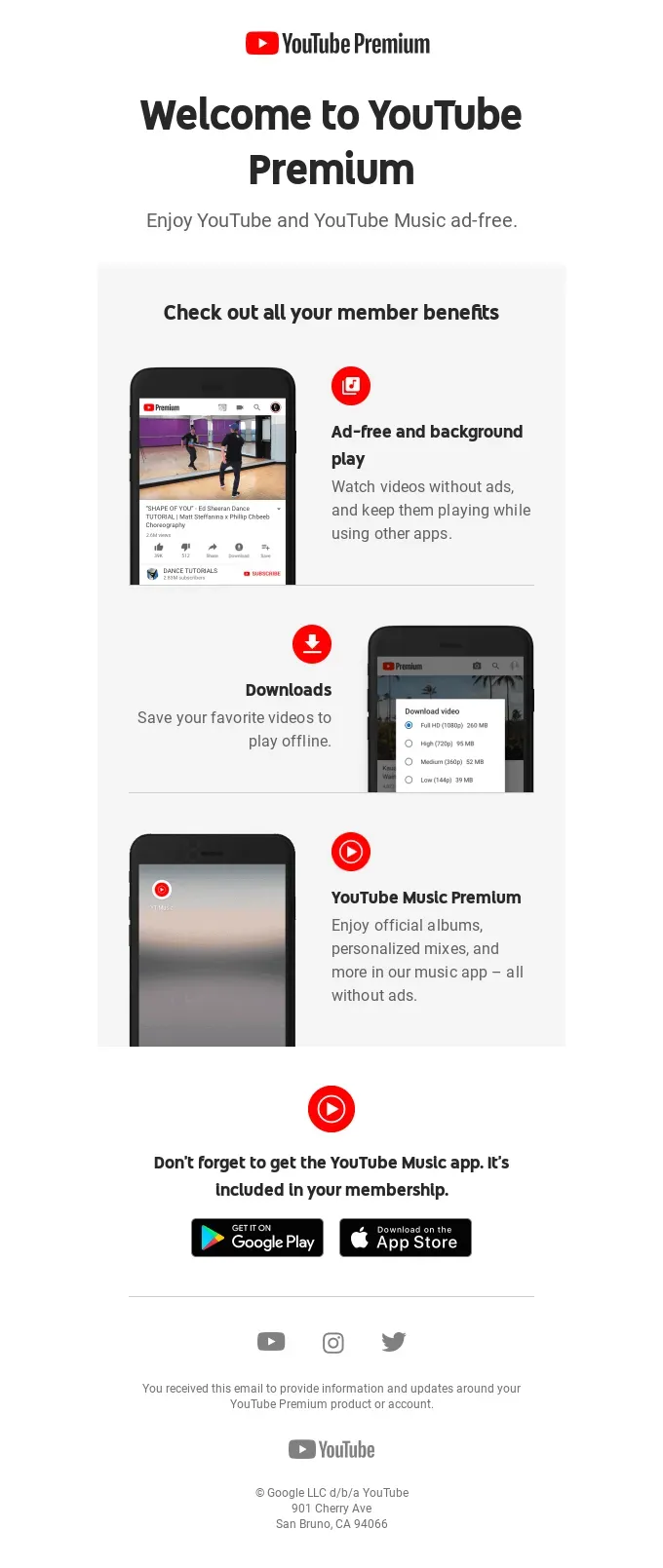
2. The loyalty email
Many businesses now understand the point of creating an email loyalty program. If a user continuously buys from your site, they will generate a form of currency or reward that they can use on future orders. As this process repeats, the shopper continues to get discounts while you improve your retention rate and sales.
You have a ton of options when it comes to actually rewarding customers for their loyalty. Some businesses prefer a points-based system where users get cash back every time they place an order. In this instance, your email reminders should let users know they’ve racked up a specific amount of credit.
It’s also common for marketers to invite people to join their loyalty email list for exclusive discounts. The example below from the clothing store Simply Be uses this style. Notice how this email says, “Remember how we said if you shopped in April, we’d treat you in May?” This is a terrific loyalty strategy because it results in the user placing two orders – one to get the discount and another to redeem their coupon the following month.
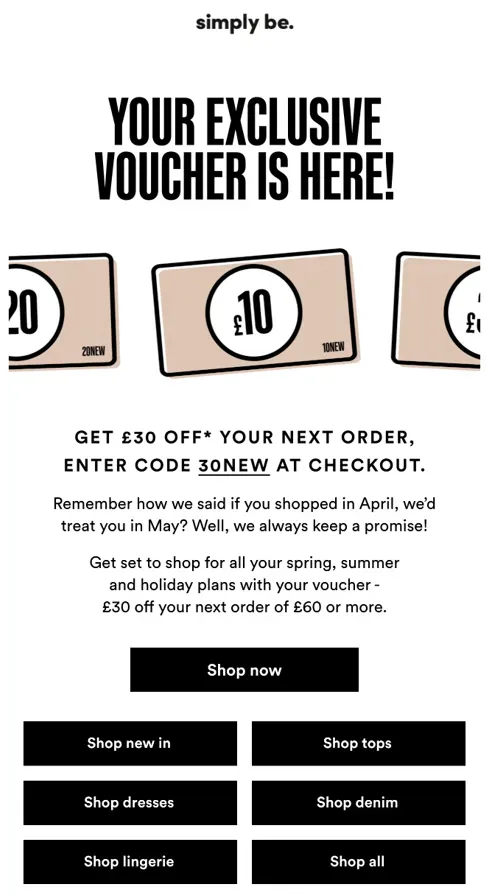
There’s a good chance you could benefit from making both of these options a part of your email loyalty program. We suggest experimenting and talking to your customers so you can find out what kind of rewards most closely match their interests.
3. The celebratory email
If you want a fun way to build loyalty with your audience, try the celebratory email! These marketing emails are a great way to personalize messages and celebrate special milestones and holidays with subscribers.
One of the most effective examples is the birthday email. The example below from Jetson illustrates how easy it is to treat your customers on their special day.
If you want to try this for yourself, ask subscribers to give you their birthday for a once-a-year promotion. Schedule the birthday emails each week to the people with a birthday within range.
Adding their name to these emails can also help. We found that personalized calls-to-action (CTAs), like “Claim Your Birthday Coupon, Tommy,” resulted in 42% more clicks when compared to generic CTAs.
I suggest creating regional holiday emails for your audience so you can further build loyalty by bringing people together. For example, an Earth Day marketing email where you promise to give back half of the proceeds to growing trees can significantly boost clicks and conversions.
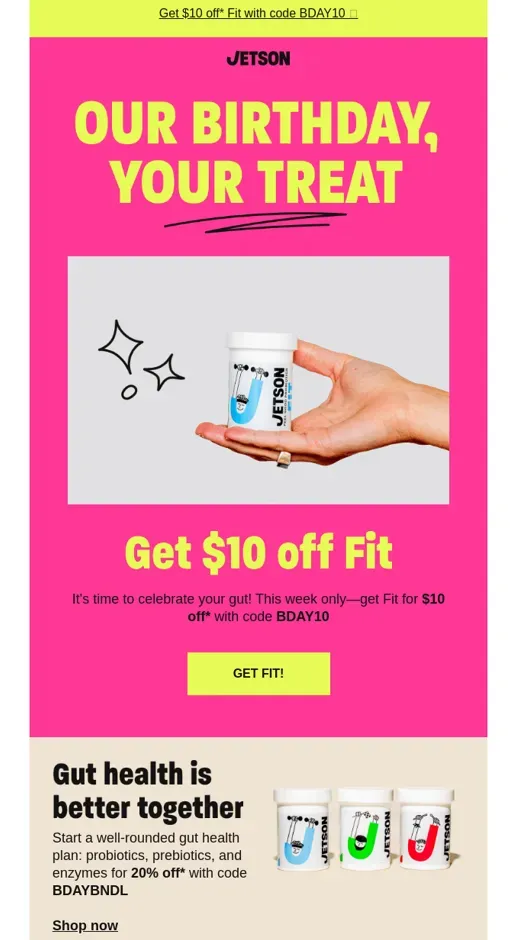
4. The reminder email
Reminder emails are a great way to keep your customers engaged and remind them about upcoming events or deadlines. You can also use them to promote special offers or discounts, as shown in our example below.
When writing a reminder email, it’s important to keep it short and to the point. Be sure to include relevant information, such as the deadline or a notice like “last chance,” as well as any relevant links or instructions.
Much like the other strategies mentioned today, it’s best to personalize these emails by including the customer’s name and information relevant to their interests or order history.
For instance, you could create a reminder email for a flash sale that only includes products from categories the customer has bought from in the past. This type of loyalty email is a surefire way to get your subscribers’ attention and turn them into repeat customers.
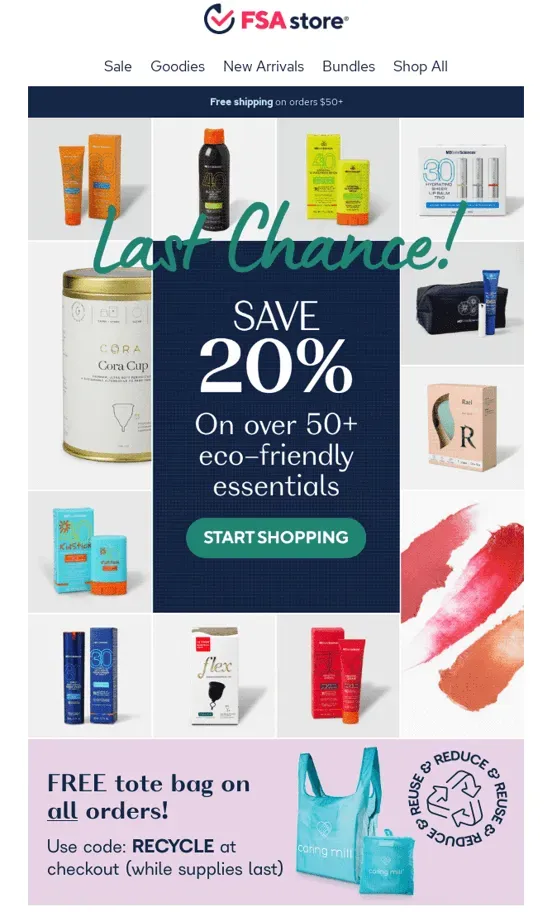
5. The social proof email
Social proof emails are a great way to build loyalty by showing customers that others love your product or brand. These messages should include things like user reviews, testimonials, or key numbers, like monthly customers. These figures and real reviews will help to convince potential customers that your product is worth buying.
Here’s a startling statistic that shows why social proof emails are so vital to your success: Around 97% of all shoppers say they will refuse to buy a product until they read feedback from real customers.
Instead of hoping users will check out your product landing page or seek out reviews elsewhere, why not take the social proof to them?
You can even tie promotions into your social proof emails. For example, we sometimes send messages saying, “See what everyone is talking about with 40% off your first order!” Once the user opens the email, they’ll see reviews from high-profile clients and a discount that they can use on your website.
If you convince people to take action, and they are happy with their order, you can bet they will tell other people, which will only help you build trust and loyalty around your brand.
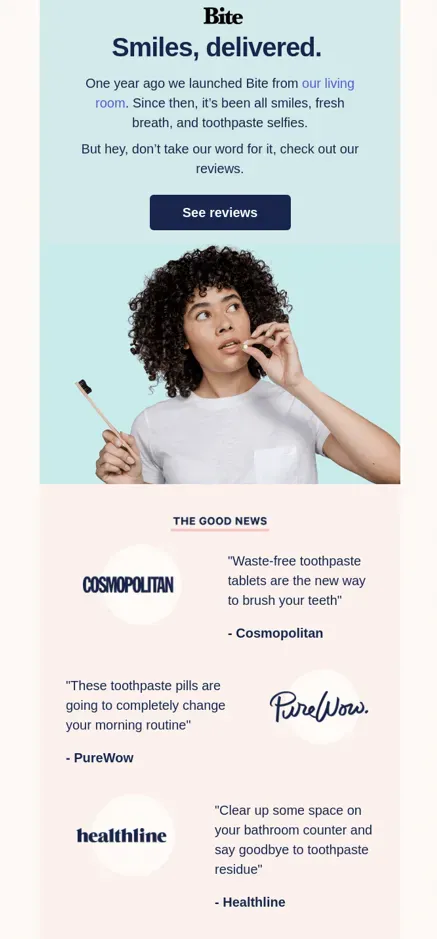
Final thoughts
As you can tell by this point, there are plenty of exciting ways to build loyalty with your customers through email. If you use the strategies mentioned in this article, you can create emails that are relevant, personalized, and engaging. When people are loyal to your brand, you can expect a significant boost in clicks, conversions, and customer satisfaction.
Here are nine different types of customer appreciation emails including real-life examples. Let’s get started.
1. Gratitude Emails
Thank your customers for being customers.
This email can be simple and straightforward to tell your customers “thank you”. You can also consider sending a discount email to customers, or just a customer appreciation email by adding an additional perk such as an extended trial or free shipping code.
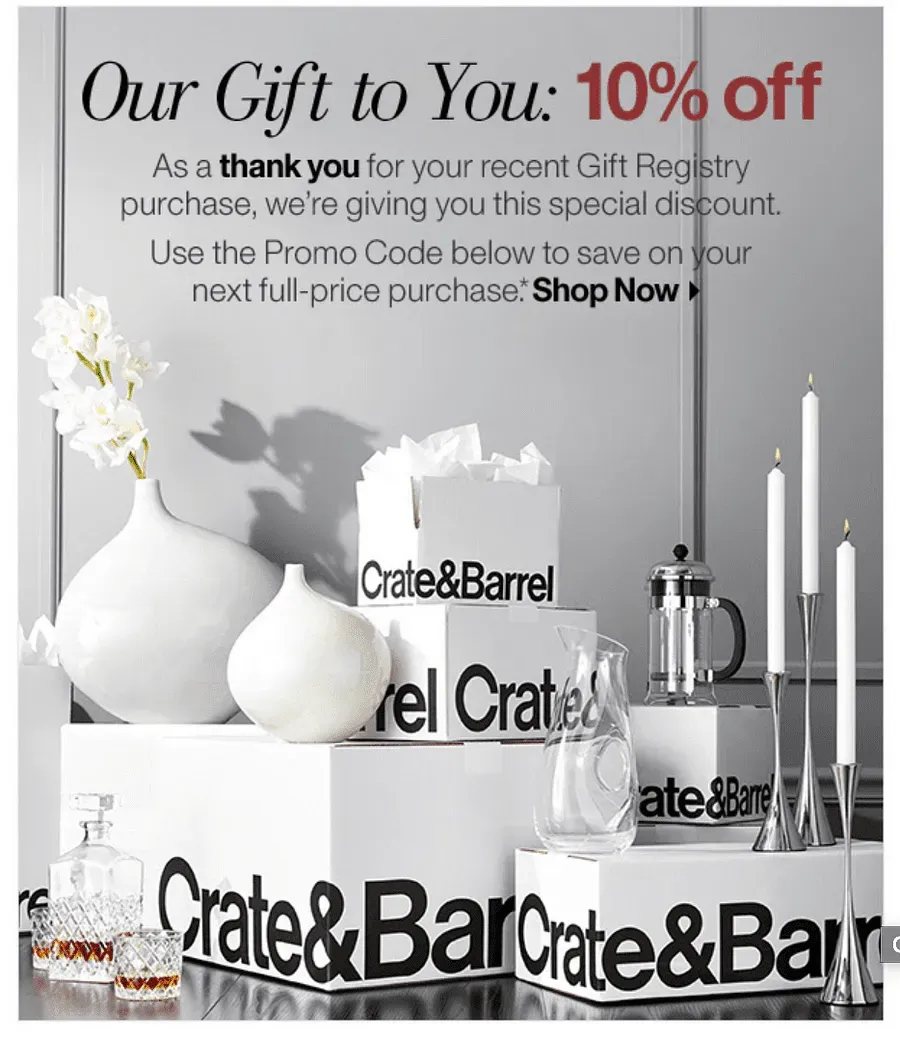
Source: crateandbarrel.com
As an example, Crate & Barrel sends an email directly after customers make a purchase. The email doesn’t feature any products or specific promotions. Instead, they simply say thanks to customers and offer a discount off their next purchase.
Not only is it a great way to show their customers appreciation, it also gives a reason to come back.
2. Early Access Emails
Keep customers engaged and feeling special by offering them exclusive perks, such as early access to new product launches or upcoming sales.
Here’s an example from Faithfull The Brand:
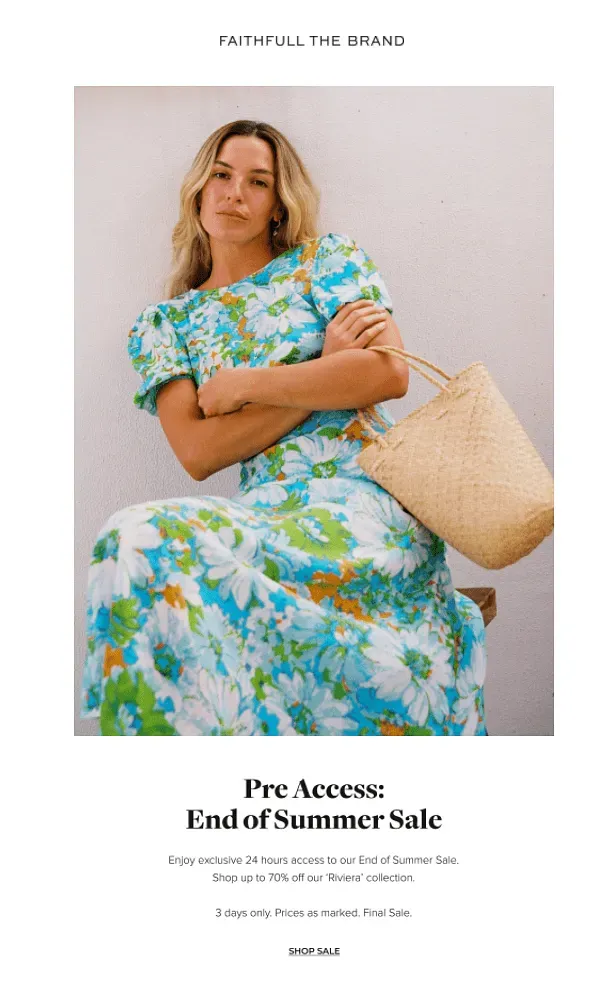
Source: faithfullthebrand.com
With a clear headline and buzzwords like “exclusive” and “access”, the clothing brand gives their existing customers a head start to the end of summer sale. The email also provides a clear CTA to a landing page, making it easy to start additional shopping incentives.
3. Birthday Emails
Birthday emails are one of the most effective emails to send to customers, having 179% higher unique click rates than promotional emails. This is because birthday emails are highly personalized, and are only given to that specific recipient.
The best part about birthday emails is that they don’t require an over-the-top effort. A simple happy birthday and complementing graphic or image works just fine.
Additionally, these emails typically will include a special offer like a discount or free gift. Aim to give your customers something that makes them feel special and valued. Sending an email without this, or with a cheap offer, could actually turn away your loyal customers.
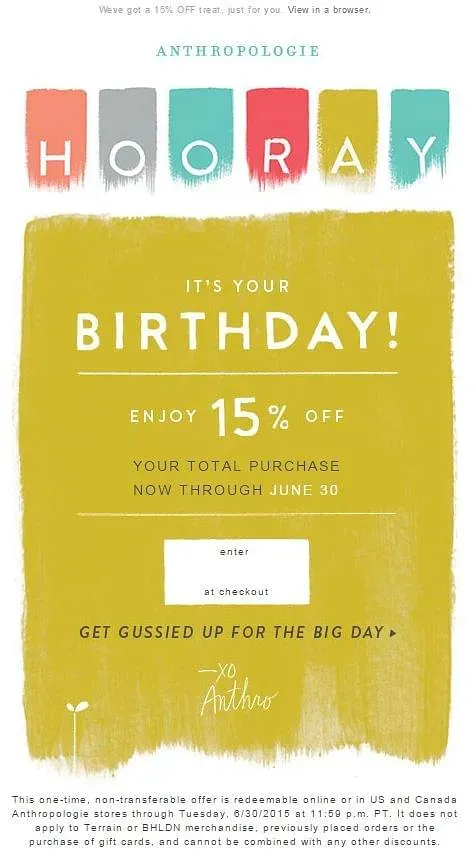
Source: anthropologie.com
Anthropologie sends simple email, wishing the customer a happy birthday and special 15% discount. It’s short, sweet and to the point.
4. Special Occasion Emails
A big part of customer retention is staying fresh in the customer's mind, and seasonal holidays are the perfect excuse to reach out and send an email.
When sending emails for seasonal holidays — like Christmas, Valentines Day, Thanksgiving, etc. — it’s important that the content is meaningful and resonates with customers. Almost every company will send something during the holiday season, but you can make yours memorable by creating customized gift guides based on customer segments or even past purchases.
Another option is to celebrate less traditional days such as local holidays or social media holidays like National Coffee Day. Sending emails for these types of holidays increases your chances for engagement, as there is less competition and lower odds of being overlooked.
Whichever special occasions you choose, it should fit both your brand and your customers.
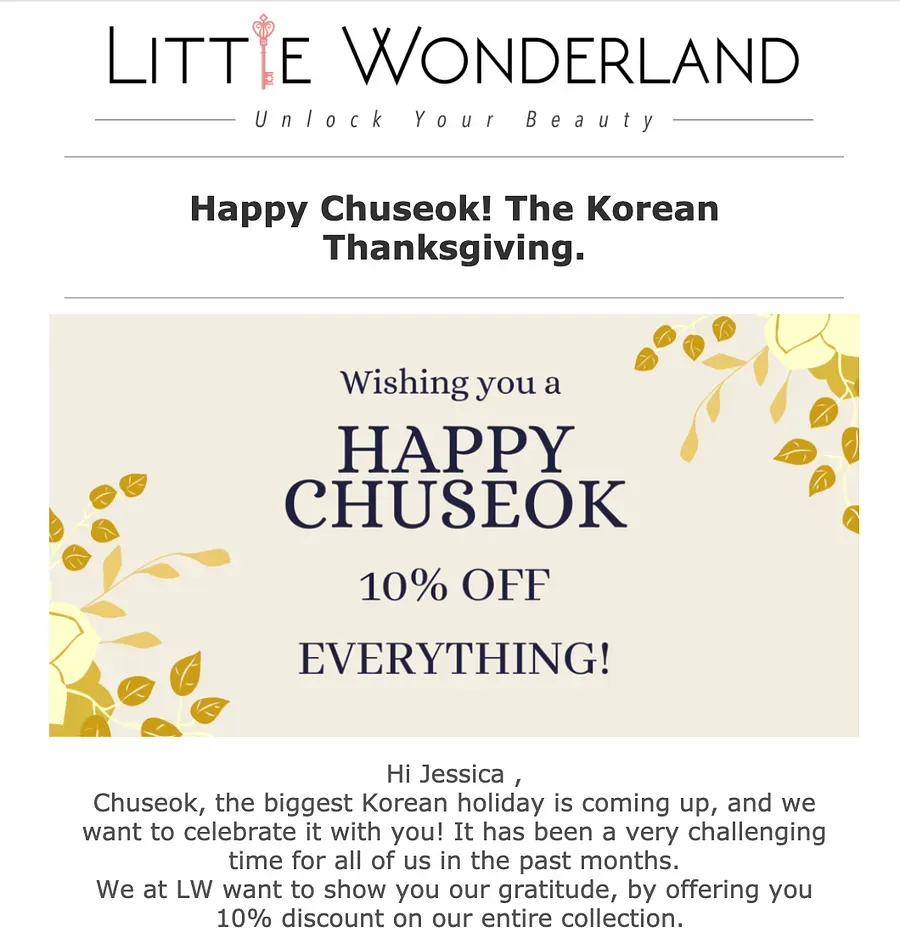
Source: littlewonderland.nl
additional shopping incentives
For example, Little Wonderland is a skincare retailer focused specifically on Korean products. They chose to celebrate the Korean Thanksgiving by giving customers 10% off. The holiday is perfectly aligned with their brand, and gave customers a nice surprise they likely weren’t expecting.
5. Milestone Emails
By acknowledging milestones, you can actively engage customers regularly and build stronger relationships.
One option is celebrating a milestone for your company, such as the number of years in business or number of customers. Send an email to share what this milestone means, the role of customers, and what makes the journey special. This is most effective when it includes a personal message, such as a written letter from a CEO or a video from employees.
Another option is a customer based milestone — focusing on their time, usage or achievements while using your products or services. This is a hyper-personalized email, specific to individual customers.
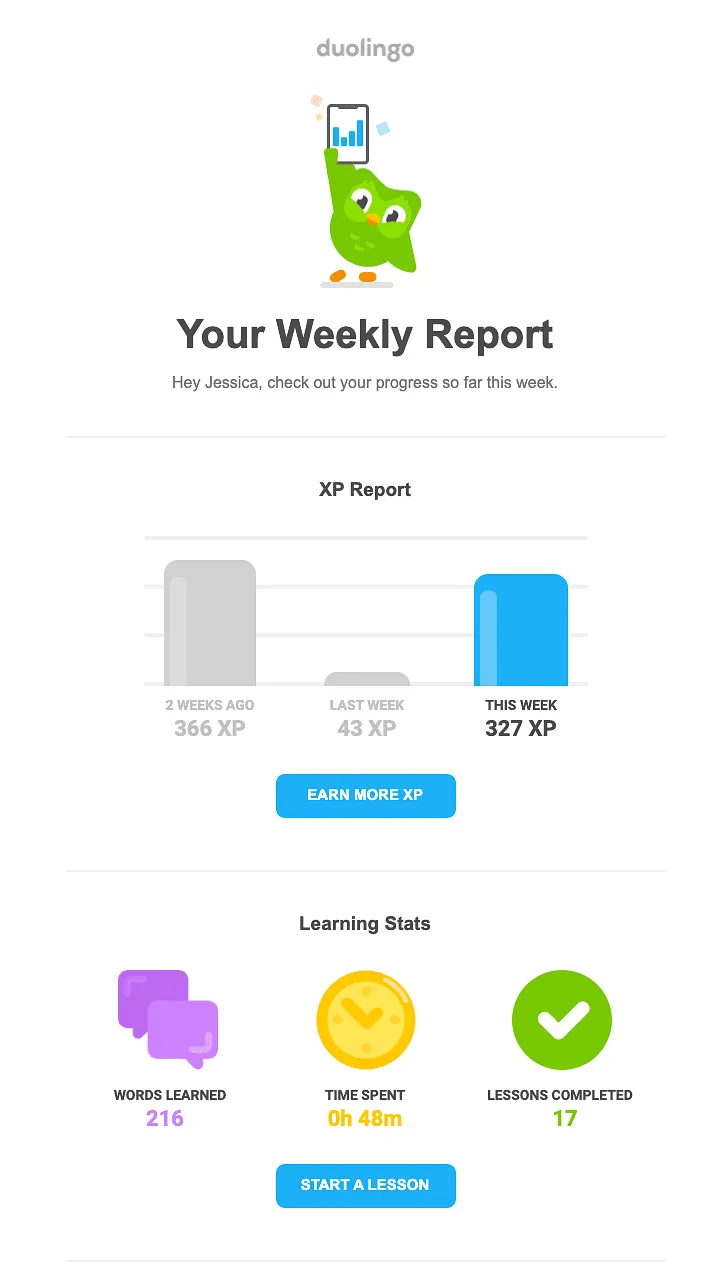
Source: duolingo.com
Duolingo does this by sending periodic emails with stats about the individual user’s progress, including how many words were learned, time spent learning, and lessons completed. While being visually appealing, this email really highlights the value in the product and the strong CTA encourages customers to keep using it.
6. Customer Referral Emails
Reward your existing customers with an affiliate or referral marketing program.
This is a win-win for both you and your customers. You are able to get extra promotion and quality referrals, and your customers are able to get rewards for recommending the products and services they already love.
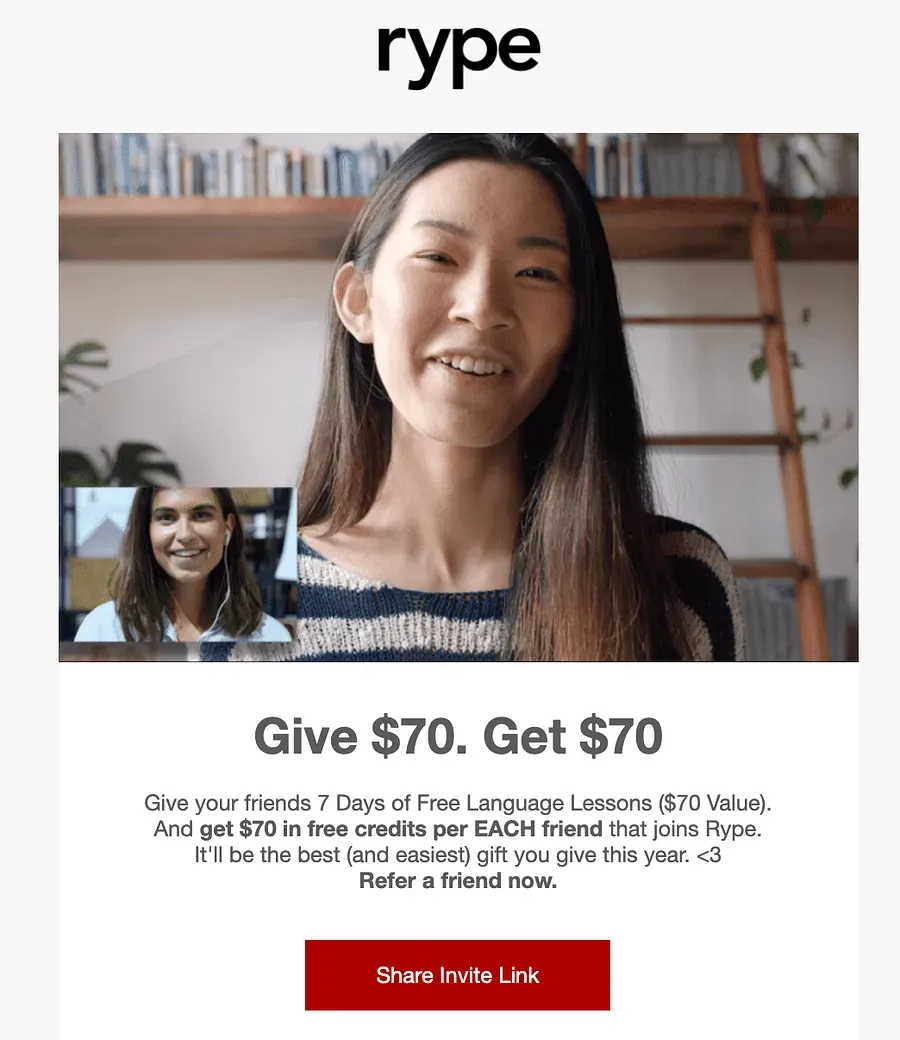
Source: rypeapp.com
Rype offers their customers the chance to earn $70 for every referral they send. The email highlights the value of earning money, uses clear headlines to communicate details, and provides a straightforward CTA. With this email, Rype has made the process hassle-free so customers can easily make referrals and earn rewards.
7. Contest and Giveaway Emails
Keep customers happy with contests and giveaways. Because after all, who doesn’t want to win free stuff?
Contests and giveaways can be tied in with other promotional efforts, such as seasonal holidays or new product launches. Since this email isn’t designed to generate leads, it’s best to keep it simple and easy to enter. Remember, the goal is to show customer appreciation and build brand loyalty — there shouldn’t be too many hoops to jump through.
In addition to giving a prize to the contest winner, you can also give a supplemental prize to those who entered but didn’t win such as an exclusive code for a small discount like 10% or free shipping. This gives your company another opportunity to touch base and show appreciation, while also giving customers an incentive to come back to your site and make a purchase.
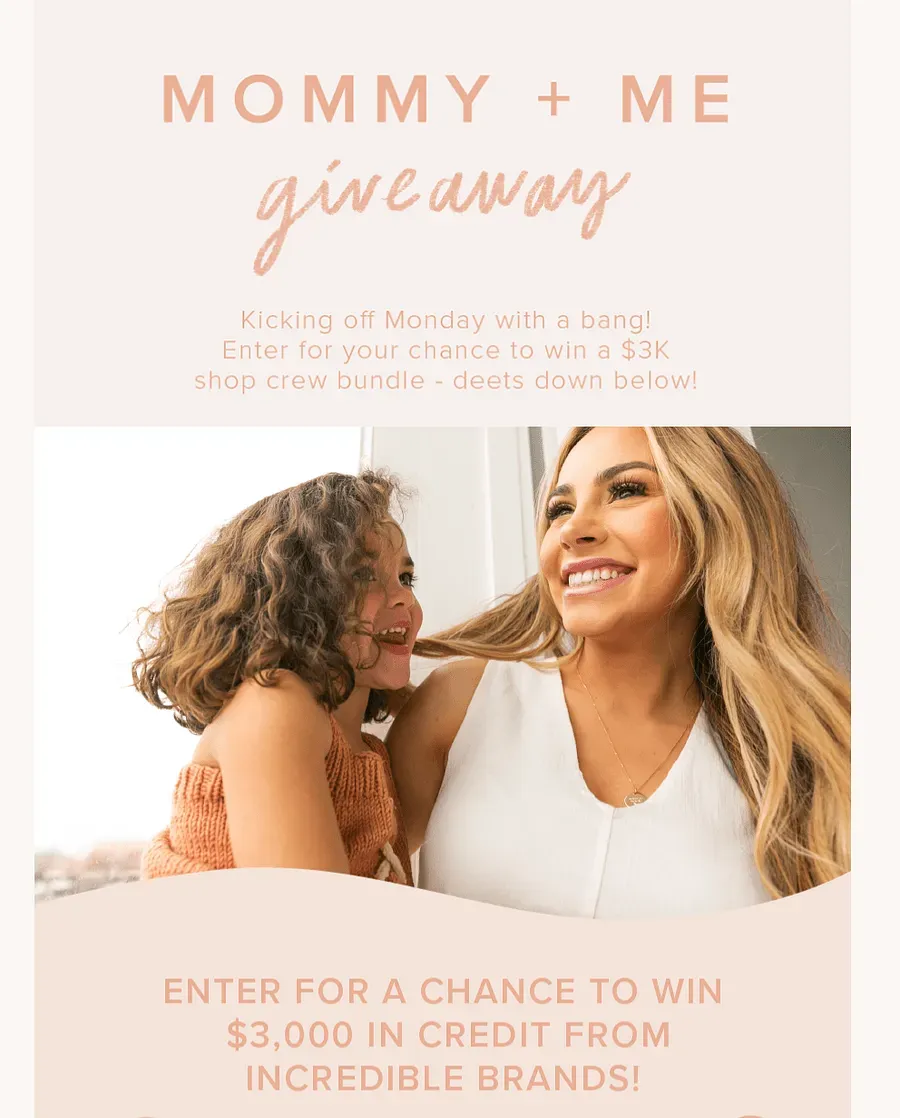
Source: madebymary.com
Custom jewelry maker Made by Mary did this by partnering with other boutique shops for a “Mommy and Me” giveaway. It was tailored to a specific persona, using fonts, colors, and imagery that appeals to their customer base.
In addition to the chance of winning a large prize, the contest also introduced customers to other like-minded businesses they could be interested in. Customers did not need to make a purchase or provide extensive details to enter, making the contest feel more like a customer perk rather than a marketing tactic.
8. Customer Reviews Emails
Asking for feedback is a great way to make customers feel heard, valued, and connected to your company.
Customer reviews are also very important to your overall marketing and growth efforts. In fact, 91% of people read online reviews – and 84% trust online reviews as much as a personal recommendation.
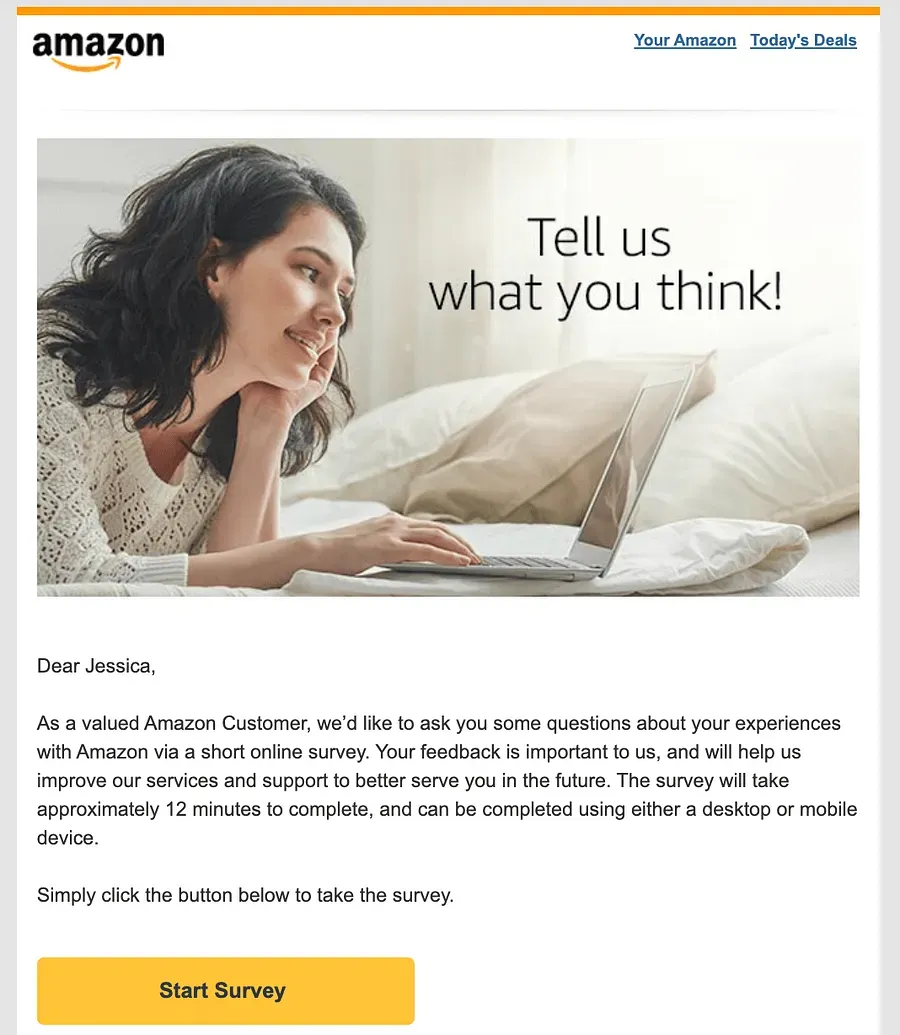
Source: amazon.com
Amazon asks customers for reviews via a short online survey. Addressed to a “valued Amazon customer”, the email quickly explains why the feedback is important, how it will be used, and how long the survey will take. This level of transparency is important to building trust with customers. Additionally, the CTA makes it easy for customers so they are more likely to take the survey.
9. “Just Because” Emails
And finally, “just because” emails. As the name suggests, these emails are sent without a particular occasion or cause, but instead “just because”.
It's a nice surprise for customers, and comes across as more genuine because there isn’t some prompt for companies to send this email. This is also a particularly effective way to re-engage with your existing customers you may have lost touch with.
However, this doesn’t mean there shouldn’t be a purpose in this email. Just saying “hello” will likely lead to more unsubscribes than conversions. Make it personalized to your customers, show appreciation, and offer them something special.
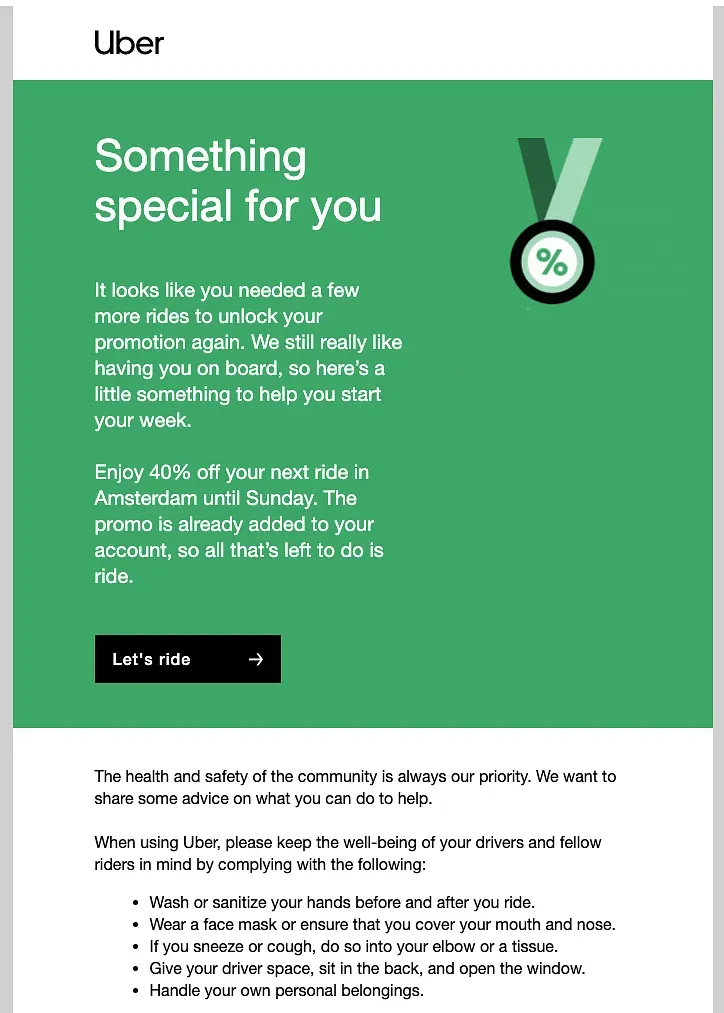
Source: uber.com
Uber’s “Just Because” email is sure to catch customer’s attention with a clear headline telling them that they are special and there is an offering waiting for them. The body of the email explains why Uber is reaching out, then follows up with a generous offer.
Start Sending Emails Today
Customer appreciation emails are a great way to make your customers feel appreciated and valued.,page, making it easy to start shopping..
But these emails are also so much more.
By offering special offers and discounts, you can increase conversion rates. Offering exclusive access can build brand loyalty. And through reviews and referrals, you can turn your existing customers into your top promoters.
Using SendX, you can begin creating customized emails like the examples above — including segmenting audiences and using a drag & drop editor to easily personalize each email. You can go for a 14-day free trial of SendX, no credit card required.
Welcome Emails
The welcome email that you send to new members of your loyalty program will lay the groundwork for the relationship with your new customer going forward. No pressure! We have a few suggestions for how you can get off on the right foot and get your new sign up excited about your loyalty program.
Tip: Remind Your User Base That They’re Insiders — Monki
Your first touch with users that have joined your loyalty program should remind them that they’ve just joined an exclusive club. As a part of that club, remind them that they’ll be receiving offers like discount codes, free shipping, and other incentivising perks.
Monki perfectly captures the insider vibe by letting users know that they’re “on the list,” encourages them to share their “Monkistyle” with other users, and offers them a discount and free shipping. Talk about starting your relationship off right!
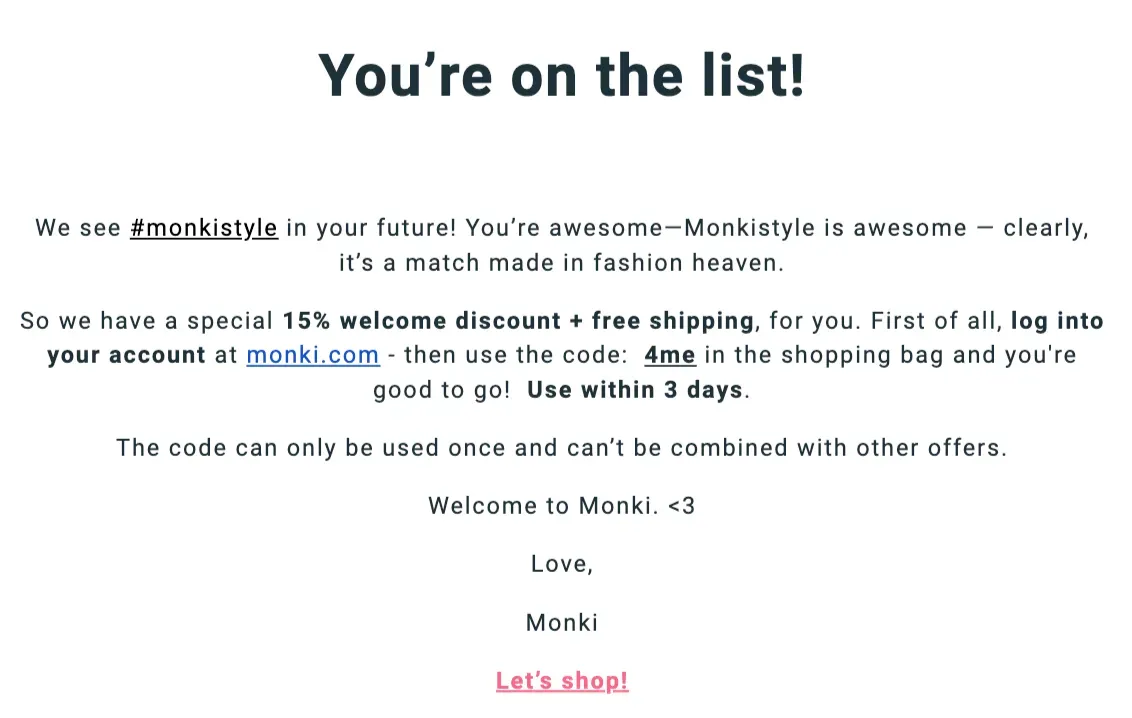
Tip: Make the Benefits of Your Loyalty Program Clear — Headstart Shop
You can’t make the assumption that new loyalty program users will know exactly how best to utilize your program or that they’re aware of all that your program has to offer. It’s smart to remind them just how your loyalty program operates and what they can expect from it in the future.
In their robust welcome email, Headstart Shop gives an overview on just how their point-based loyalty program works. Users can earn points by shopping, referring friends, and taking action on the brand’s social media pages (a great way to boost another marketing avenue). It’s clear and informative without being overwhelming.
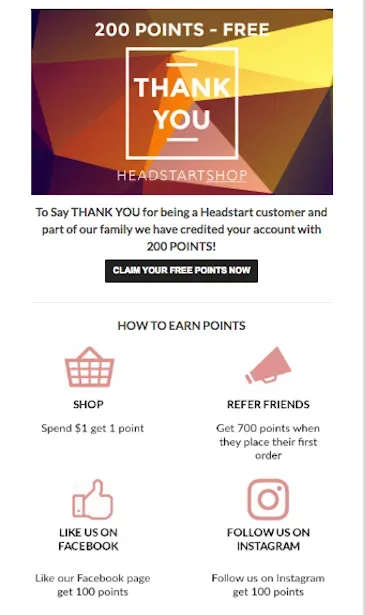
Email Rewards Campaigns
Next we’ll experiment by planning some email rewards campaigns yourself. But remember, you’ll want to craft an ideal customer profile so you don’t waste time and money targeting luke-warm prospects. For inspiration, consider learning from these loyalty program examples:
Tip: Importance of Personalization — The Savoy

Consumers expect brands to deliver personalized marketing content to a greater degree than ever before. For example, you may already know that segmenting your email list to enhance personalization results in a higher open rate. You need to account for the individual tastes and preferences of each customer when sending emails.
This same principle applies to loyalty emails. For instance, The Savoy sends customer rewards emails based on the preferences of each recipient. If a customer is planning a trip to a particular destination, the emails are designed to provide them with destination-specific recommendations. This is a simple yet effective way to make the best possible impression on all email list followers.
Tip: Keep Things Simple — The Gap
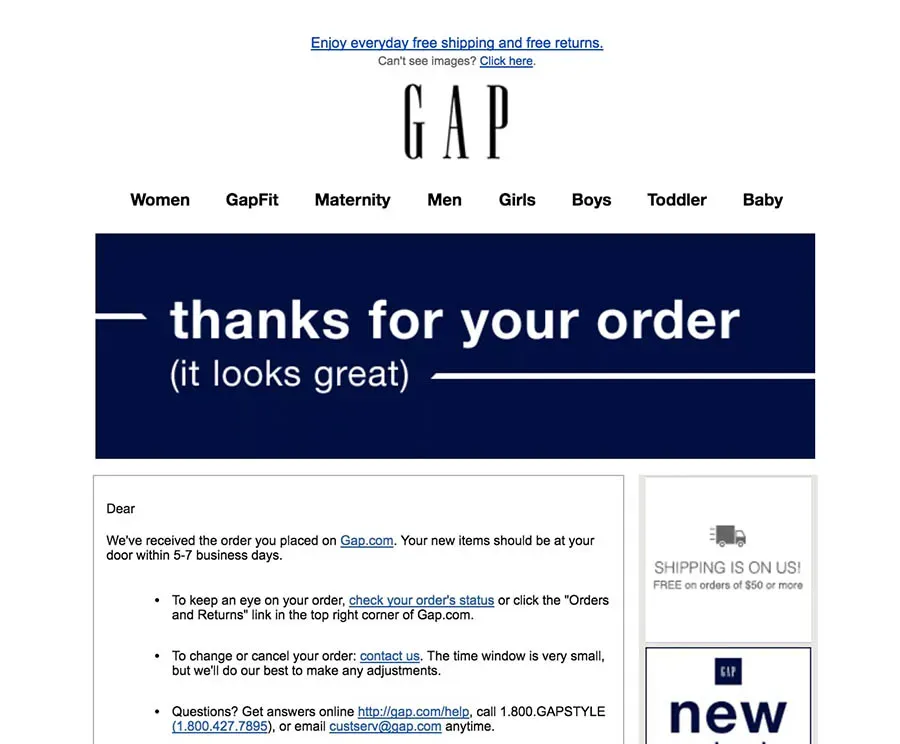
Brands such as The Gap have generated higher-than-average clickthrough rates (and as a result, higher levels of engagement) by merely sending customers thank you emails when they make purchases.
You can enhance such emails by offering special discounts or rewards when customers spend a certain amount of money. This is yet another loyalty program example that highlights the value of simply treating your audience members as respected individuals.
Tip: Expand Your User Base with Customer Rewards Emails — Hotel Tonight
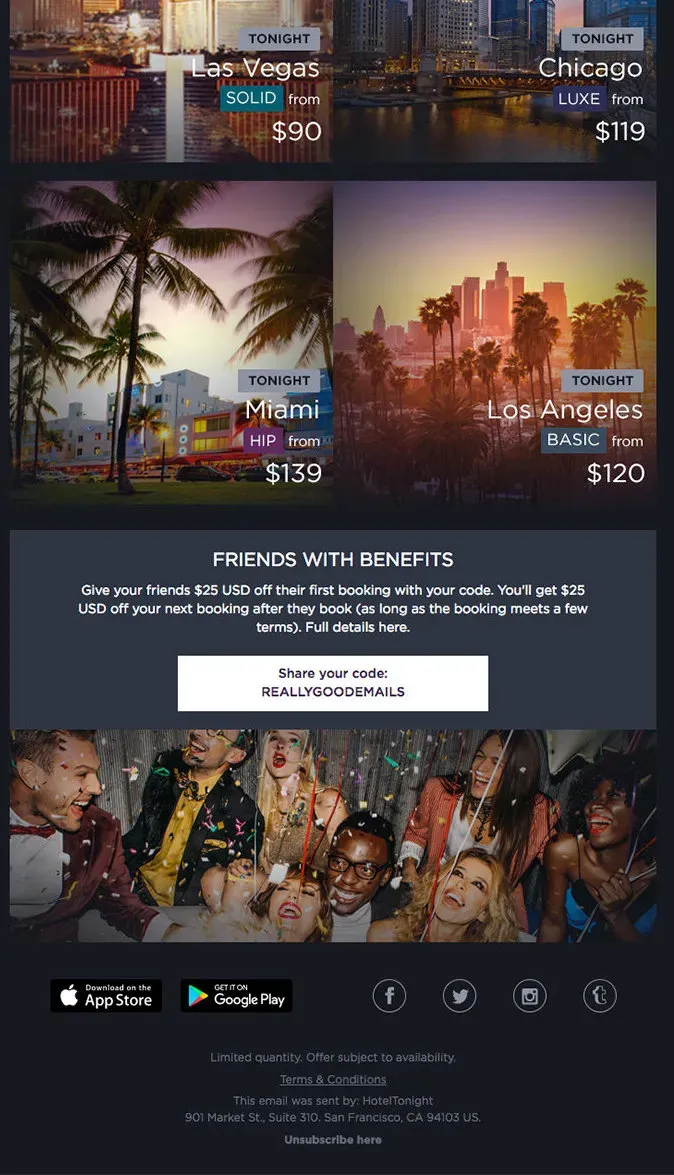
Hotel Tonight offers a loyalty program example that demonstrates how such programs can not only boost brand loyalty among current customers, but also attract new ones.
The company achieves this goal by sending emails to its loyalty members with referral codes they can use to earn a $25 reward when they convince a new friend or family member to sign up for the service. This rewards the loyalty of existing customers while also consistently growing their user base.
Though it may not be right for every brand or business, paid customer loyalty or VIP programs can be incredibly effective. For a paid program like this to work, you’ll have to target customers that frequently visit or make purchases on your site. Unless you’re already a large, familiar brand, new customers will be a harder sell since they’ll have no built in familiarity or trust with your brand.
However, enticing member-exclusive benefits will keep your loyal customers coming back time and time again. Make sure you use your emails to highlight the value of your paid loyalty program. As long as the value of your VIP program is greater than the cost, people will sign up. Include testimonials from existing loyalty program members as an extra boost.
Tip: Send Happy Birthday Emails, A Staple Among Loyalty Program Examples
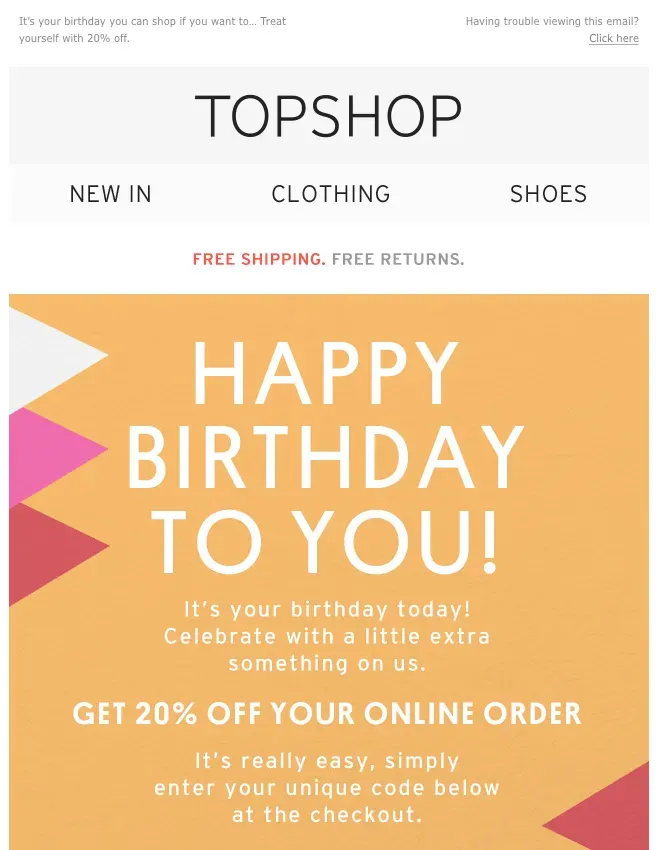
It’s important not to overlook the value of tried and true methods when developing email rewards campaigns. For instance, seemingly countless brands have successfully boosted engagement and customer loyalty by sending discounts or special offers on a follower’s birthday.
Topshop, for example, keeps things simple with a clear message, offer, and how to use the discount. Birthday emails reward customer loyalty, feel more personalized than most marketing emails, and make a customer feel they are truly valued.
Re-engagement Campaigns
Tip: Foster Loyalty With Charitable Giving — The Body Shop
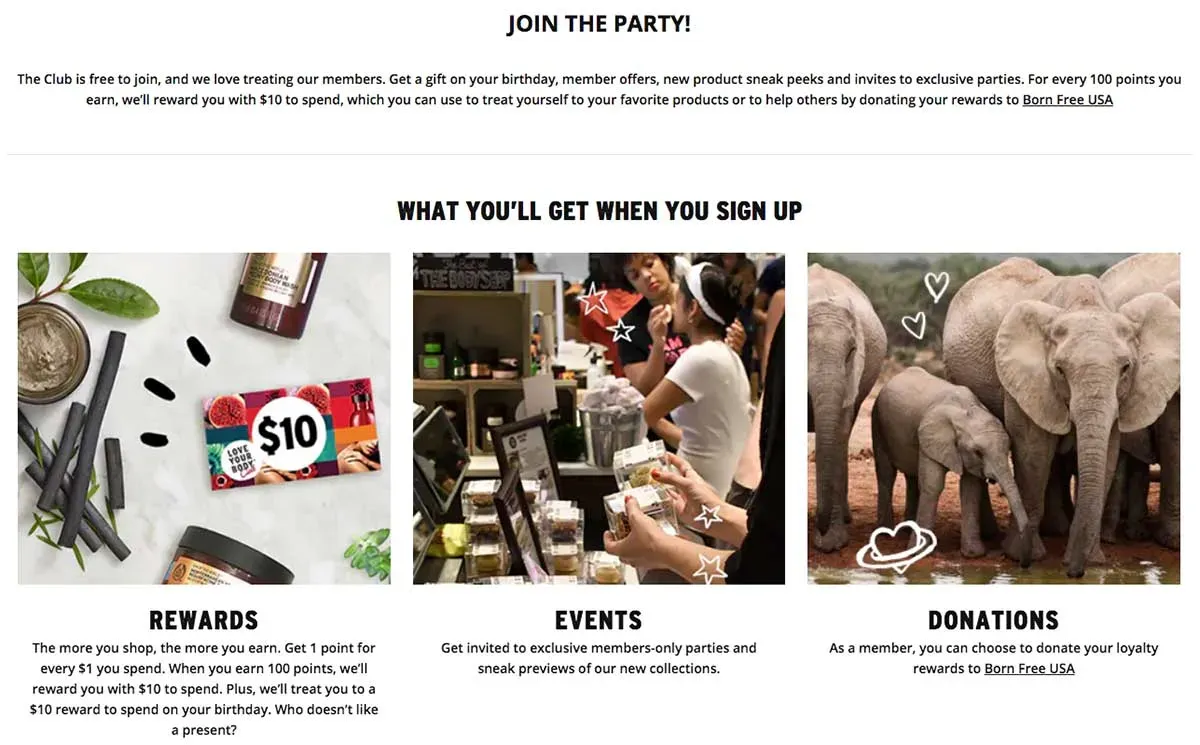
Not every loyalty program has to offer discounts to customers. Sometimes a brand can foster loyalty and increase engagement by highlighting their company’s ethics and values. If your brand and your customers share mutual values, you can build a loyalty program around those shared beliefs that will forge an even stronger connection between yourself and your customers than what a discount could create.
For instance, The Body Shop strongly believes in environmental sustainability and animal welfare. When customers join their rewards program The Club, not only do they receive discounts and VIP benefits, but they also have the ability to donate their rewards to Born Free USA (a charity for animal welfare). Not only does this program allow customers to see the causes that are important to The Body Shop, but if customers share passion for similar causes, it will create a deeper relationship.
Tip: Take a Seasonal Approach — Nordstrom Rack
It’s no secret that marketers, especially in the retail industry, use seasonal events and holidays as inspiration for email marketing and loyalty campaigns. Email marketing is routinely most effective when your messages are in some way related to holidays or events happening that season.
For example, Nordstrom Rack makes great use of a gif inspired by Valentine’s Day to promote gifts under $25 for their users and also subtly uses the email header to remind users that they’ll receive free shipping if they spend more.
Remember, it’s easy to graze over some of the lesser-known holidays and events. By remembering to plan campaigns around these under the radar dates, you might enhance visibility and engagement to your message.

Tip: Promote Exclusive News, Products and Perks — Casper
Exclusive announcements are exciting, whether they pertain to big changes in your business, a new product offering, or new member-only benefits. By labeling something as an exclusive, your message inspires inquisitiveness and users will make a mental association between your brand stimulating insider information.
For instance, when Casper launched a new version of their mattresses, they framed it as a groundbreaking announcement that they were letting their registered users in on early. They even make an effort in the copy to point out the attention that they pay to their customers and feedback. Even if you’re not launching a new product, you can learn how Casper frames this email as incredibly important to its registered users.
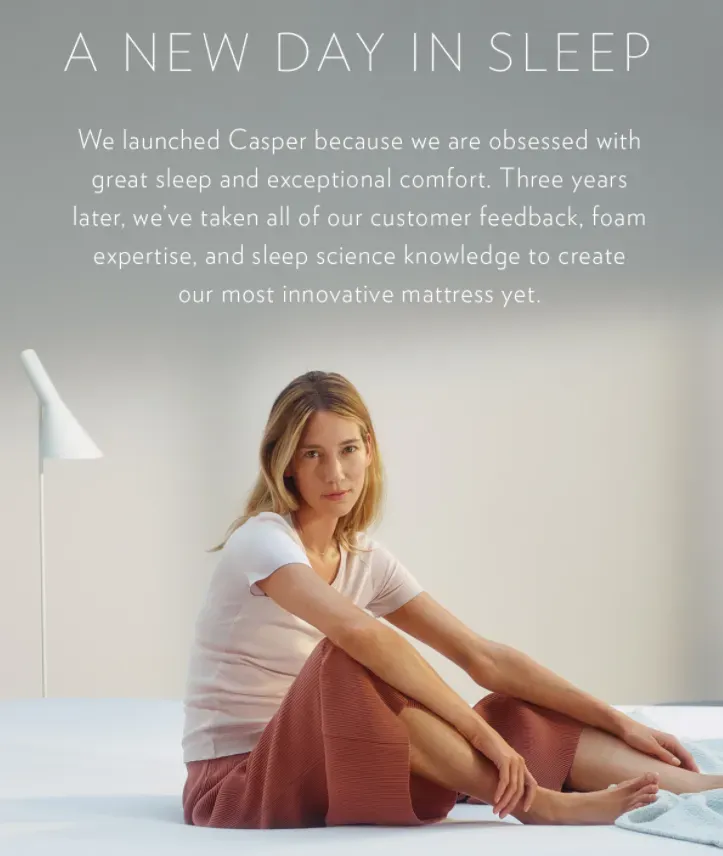
Use these loyalty program tips and examples as inspiration when developing your own campaigns. They’ll help you come up with emails that deliver a strong return-on-investment while improving overall customer satisfaction, too.
Types of customer loyalty emails
Any email you send your customers can be considered a loyalty email—so long as you’re adding value. So let’s take a look at a few different types of emails, what they are and how to use them to build customer loyalty.
Welcome emails
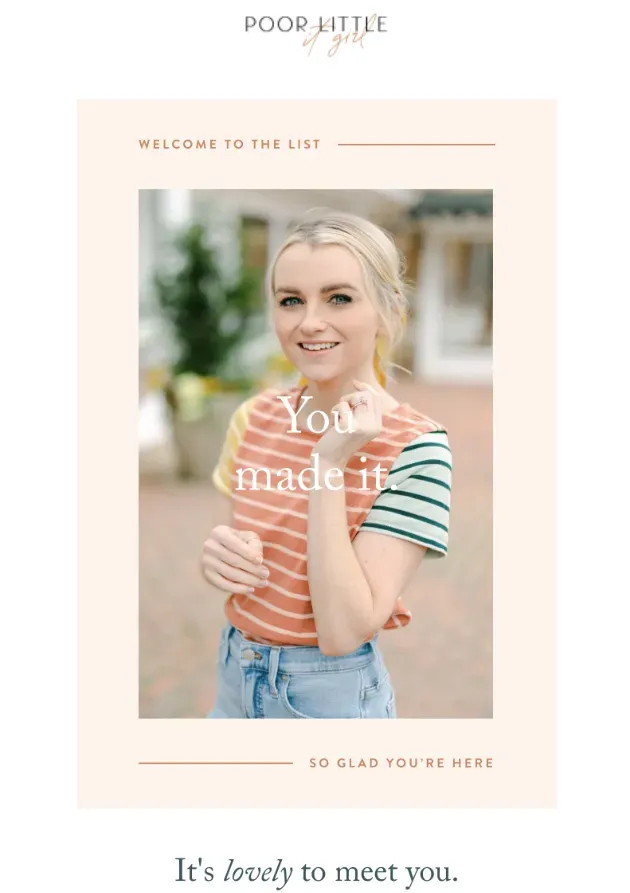
As you might guess, welcome emails are used to welcome newcomers to your brand or community. They’re typically sent when someone subscribes to your newsletter or signs up for something else on your website—like the above example from Cathy over at Poor Little It Girl.
Here are a few tips for building customer loyalty with welcome emails:
-
Use welcoming language like “welcome to the list” or “we’re so glad you’re here” to communicate acceptance and belonging.
-
Include a personal photo of yourself or your team to make an emotional connection with the reader.
-
Automate your welcome emails so that new subscribers receive your message immediately after signing up.
Want more subscribers to send welcome emails to? Read: 11 Email Marketing Lead Generation Tactics Your Subscribers Will Love.
Special offer emails
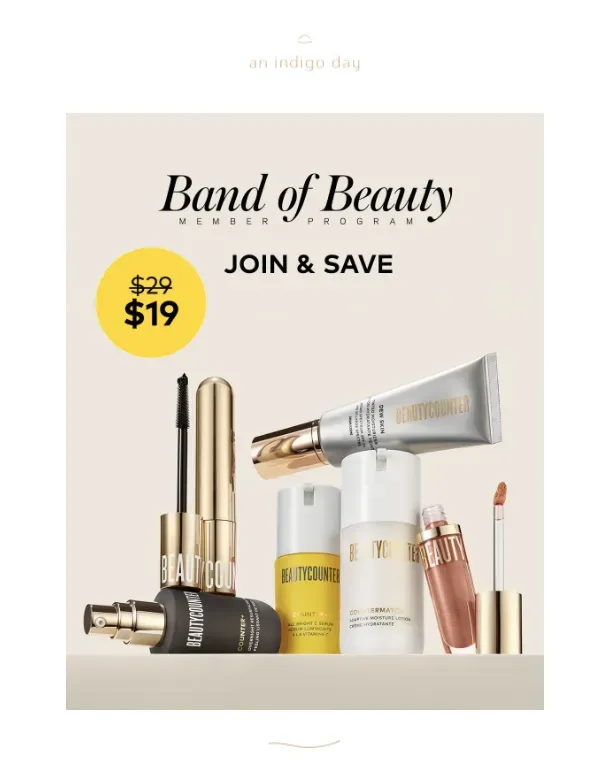
Loyalty programs are all about the perks! In this email from Jessica over at An Indigo Day, she shares a special deal with her subscribers so they can save $10 on a Band of Beauty membership. Here are a few tips for sending special offer emails:
-
Make sure the offer is relevant and valuable to the reader. Oftentimes, this means you need to segment your emails so you can send targeted offers to different groups.
-
Include clear CTA buttons and links so that loyalty program members can easily redeem the offer or participate in your rewards program.
-
Communicate that it’s a special offer for subscribers only as this will increase feelings of loyalty and the perceived value of remaining on your list.
Product update emails
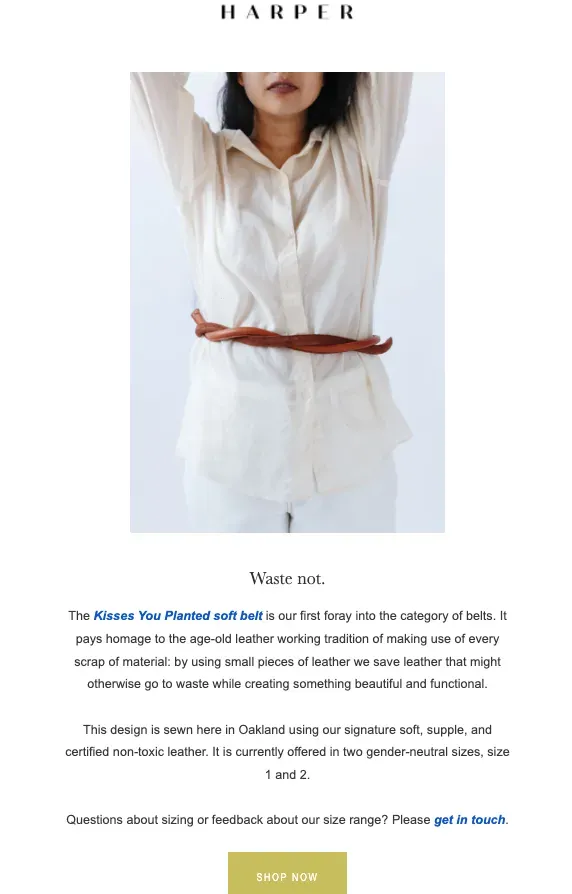
Another perk you can extend to your customers to inspire loyalty is insider access to product launches or updates. This email from Harper The Label is a great example. Here are a few tips for product update emails:
-
Include an image of the new product whenever possible, like Harper does above.
-
If it’s a product update, explain how the new product improves upon the existing one and why it’s good for your customers. A story can be a powerful tool here. Not only will it explain the purpose behind the update, but it can also make customers feel like they have “behind-the-scenes” access to your team.
-
Always include on-brand CTA buttons or links so that loyal customers can easily visit your website or landing page to make purchases.
Learn more about product update emails: 10 Product Update Email Template Examples & Best Practices.
Newsletter emails
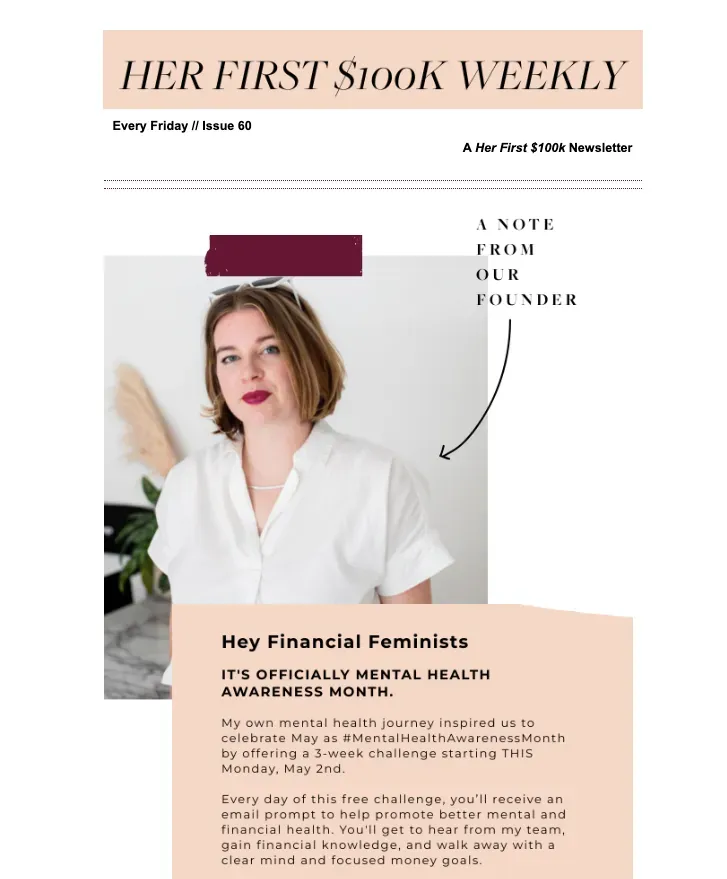
Newsletter emails are great for loyalty programs because they give customers the inside scoop on your business. Tori from Her First 100k uses this newsletter email to invite her community members to join her in a 3-week challenge to promote better mental and financial health. Here are a few tips on building loyalty with newsletter emails:
-
Send them on a regular basis (but not too frequently). As a point of reference, 61% of subscribers would like to receive brand emails every week.
-
Use automation to help you get the most out of your newsletters for the least amount of effort. This involves setting up an automated email sequence, called a workflow, that sends emails to your subscribers at specific times or in response to specific inputs.
-
Share high quality content that’s relevant and valuable for your audience. This can include actionable advice, helpful article recommendations, and tools to stay inspired and productive.
Thank you emails
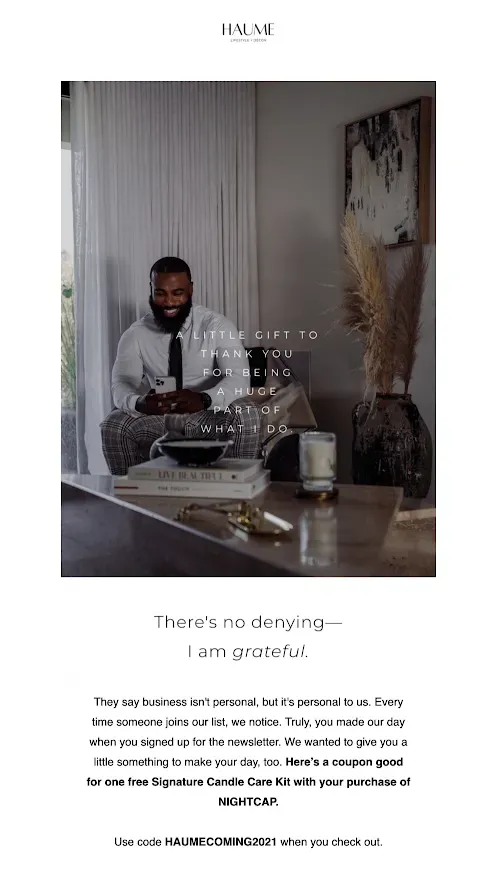
In this thank you email from Haume, a lifestyle and home decor brand, new subscribers are rewarded with a free gift. Here are a few tips for building loyalty with thank you emails:
-
To make your “thank you” sound sincere, use welcoming language and write in the same way you would talk to the reader in person.
-
Use thank you emails to create a good customer experience, similar to what people are used to when shopping in person. Brands with superior customer experience bring in 5.7 times more revenue than those without.
Check out our favorite thank-you email templates for e-commerce!
Re-engagement emails
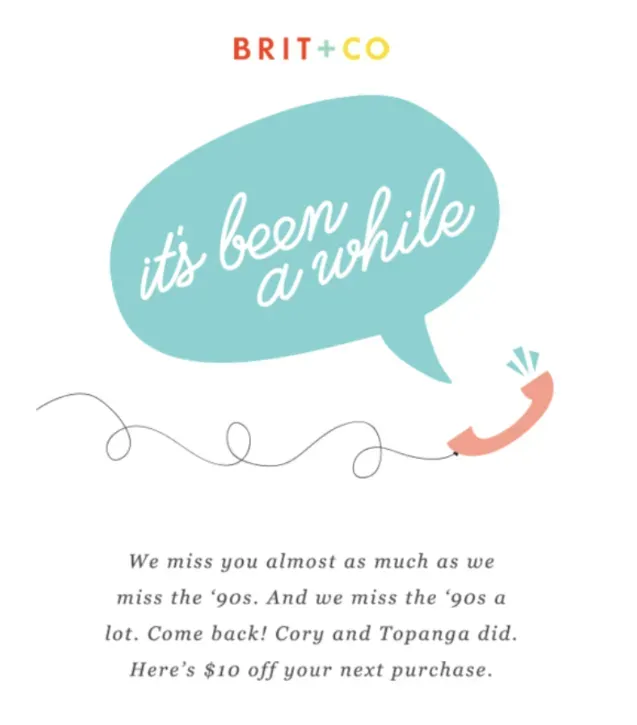
A re-engagement or win-back email is a marketing email sent to inactive subscribers, or to subscribers who don’t open or click your emails anymore. Its aim is to bring back people who’ve stopped engaging with your emails.
This re-engagement email from lifestyle brand Brit & Co. uses a dash of nostalgia along with a $10 coupon to draw customers back in. Here are some tips for using re-engagement emails to bring back loyal customers:
-
Take the time to craft the perfect subject line. If your subscriber hasn’t been opening your emails lately, you’ll have to come up with something that grabs their attention right away.
-
Provide something of value in your email. One of the most common offers you’ll find in a re-engagement email sequence is a discount code for between 10-20% off a purchase.
-
Give subscribers a chance to change their preferences. Maybe they don’t want to receive as many emails, or maybe they’re ready to unsubscribe. It’s never fun to lose subscribers, but it can ultimately be a good thing—your email list might be a little smaller, but it’ll be full of better quality subscribers.
Want more details on re-engagement emails? Read: How to Write a Re-Engagement Email to Win Back Lost Subscribers.
Get unlimited email sends & subscribers with Flodesk
We’ll never increase pricing because your email list is growing
START FREE TRIAL
8 loyalty program email examples
Now that you know the different types of loyalty program emails, here are some real-life examples to get you started.
1. Hair For The Girls welcome email
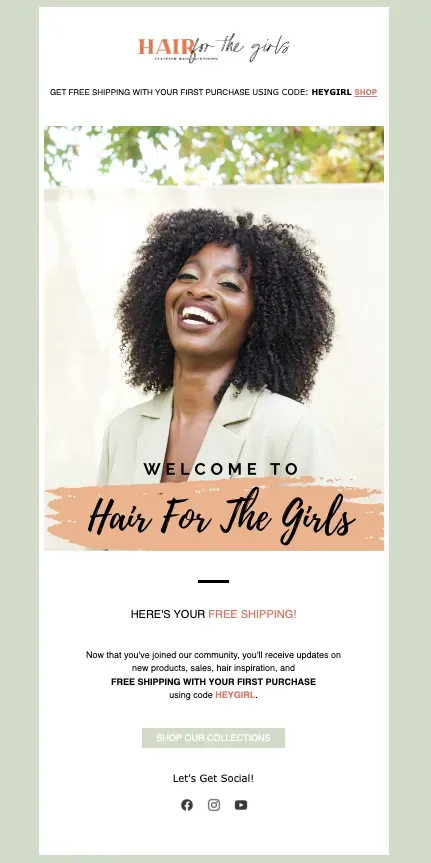
In this email from Hair For The Girls, co-owners Yvette and Lindsay welcome new subscribers with a coupon for free shipping on their first purchase. Here’s why this email works:
-
It makes a great first impression on readers thanks to the beautiful design and on-brand colors and fonts.
-
It rewards new subscribers with a discount code that’s on-brand and easy to remember (HEYGIRL), creating a positive customer experience.
-
It makes shopping easy by including a link at the very top of the email plus a clear CTA button at the bottom.
2. The Little Posy’s newsletter

In this loyalty-building email from The Little Posy Co, the company shares images of and stories about their growers with their subscribers. Here’s why this email works:
-
It uses beautiful, eye-catching photos to break up the longer sections of text and encourage readers to keep scrolling. (Seriously, those hydrangeas!)
-
It reminds people of the brand’s dedication to sourcing its flowers locally—which is a good move, considering 79% of Americans say they’re more loyal to purpose-driven brands than traditional ones.
-
It’s a monthly installment of a regular newsletter, so customers are expecting to receive it and probably looking forward to it. In fact, 90% of customers want to receive newsletters “at least monthly,” and just over 60% of those want emails “at least weekly.”
Read next: How to Monetize a Newsletter: 6 Proven Methods (With Examples).
3. Moodelier’s special offer
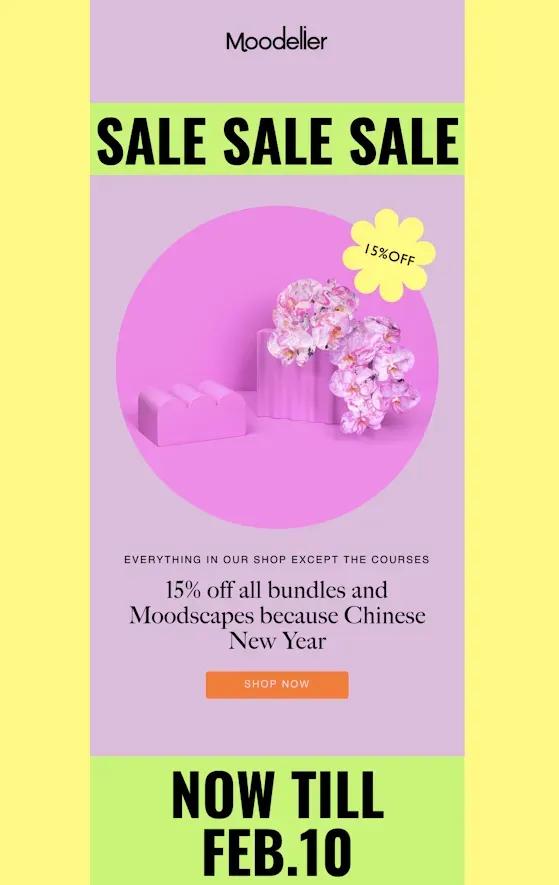
This email from the creatives over at Moodelier rewards loyal subscribers with a special limited-time offer of 15% off all bundles and moodscapes. Here’s why this email works:
-
It grabs readers’ attention with bright, bold colors that are on-brand and complementary to the product image.
-
It delivers the entire message in a single glance—a good thing considering people spend an average of just 10 seconds reading a brand email.
-
It features a single, clear CTA button encouraging readers to “Shop Now.” We recommend using only one CTA whenever possible (and never more than three). If you have multiple CTAs encouraging multiple actions, the reader can get overwhelmed with choices and abandon the whole thing.
4. Lu France Interiors’s milestone celebration
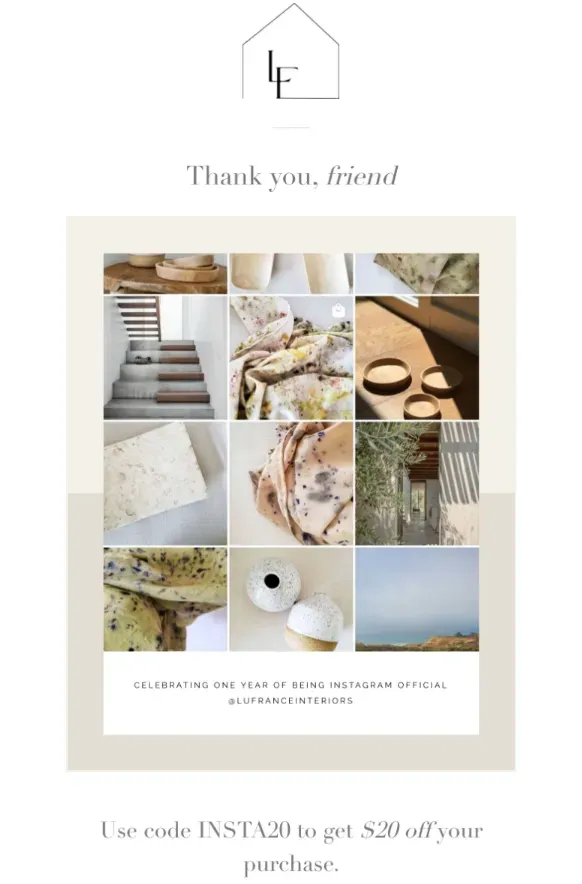
In this email from the artisanal home decor brand Lu France Interiors, loyal subscribers are invited to join them in celebrating one year of being “Instagram official.” Here’s why this email works:
-
By leading with the phrase “Thank you, friend,” the email manages to communicate the purpose of the email while still leaving a bit of mystery so that readers continue on.
-
The $20 off discount is likely to have a high perceived value for most customers, making them feel appreciated and valued.
-
It makes customers feel like they were part of the journey, building a sense of community.
Saffron Avenue’s product update
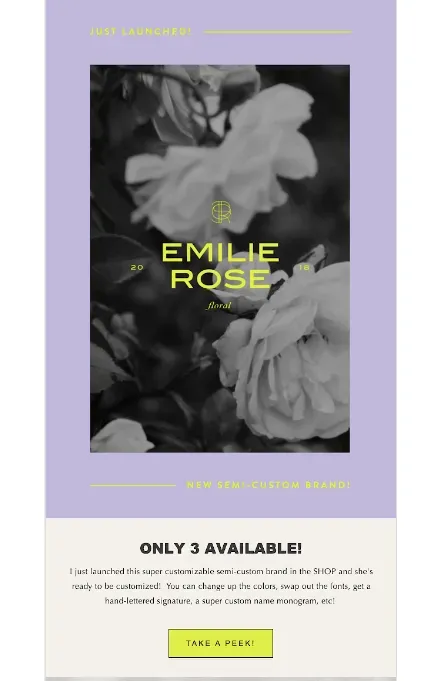
This email from branding agency Saffron Avenue gives loyal customers a first peek at a new, limited edition product. Here’s what makes this email work:
-
It creates a feeling of exclusivity and makes customers feel valued by giving them early access to a new product launch.
-
Its copy communicates a feeling of urgency with the combination of “Just Launched!” “New Semi-Custom Brand!” and “Only 3 Available!”
-
The unique, actionable language used in the CTA (take a peek) tells readers exactly what will happen if they click through.
For more inspiration, check out these examples of great teaser email campaigns for your next product launch or update!
6. Harper The Label’s “thank you” email
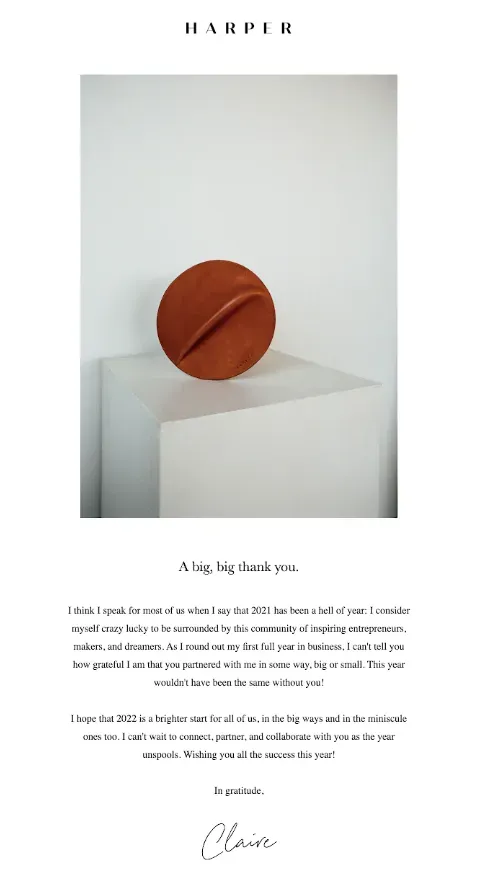
In this email from Claire over at Harper The Label, she celebrates one year in business and thanks subscribers for helping her get there. Here’s why this email works:
-
It uses a sincere, personal message of gratitude to connect emotionally with readers. Plus, it’s signed “In gratitude” and features a personal signature from the brand’s founder.
-
It communicates a sense of a shared journey, making subscribers feel like they’ve been a part of something.
-
It doesn’t try to sell the reader anything, adding to the sincerity of the email.
7. Cheeks & Co’s social media contest
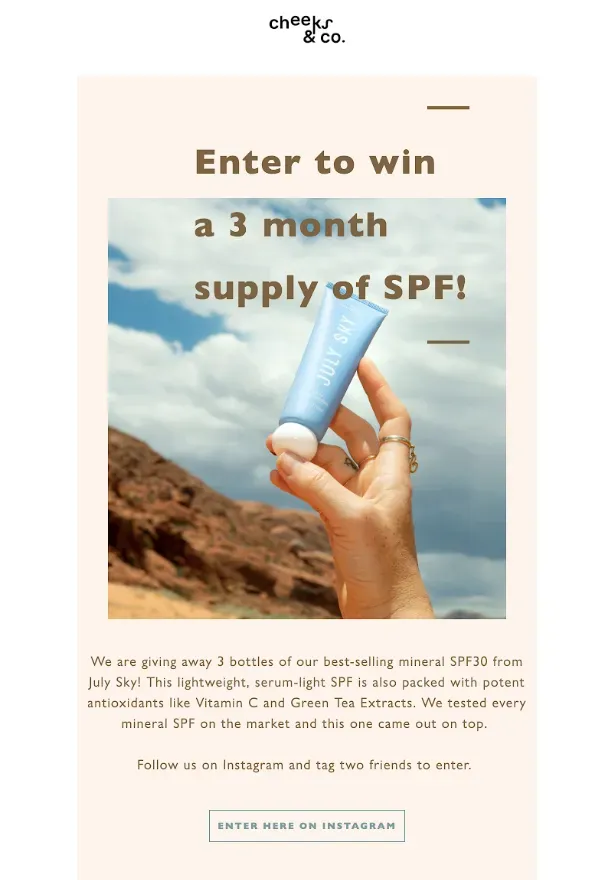
In this email from Cheeks & Co, the skincare brand invites customers to enter a contest to win a three-month supply of SPF lotion. Here’s why this email works:
-
Contest emails have the highest average open rate compared to other email campaigns.
-
To enter the contest, customers need to follow Cheeks & Co on Instagram, which will open up another channel for engagement.
-
It uses a relatively high-value prize to entice readers to take action—often necessary when running a contest or starting a customer loyalty program.
8. Allison Patel Photography’s “follow-up” email
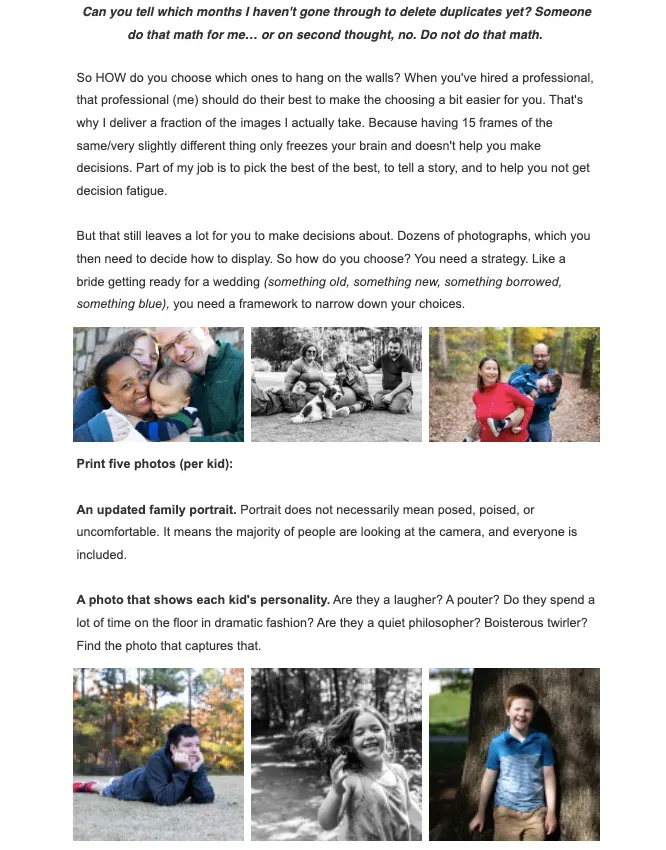
In this email from Allison Patel Photography, she follows up with readers to see if they’ve taken action on an assignment from a previous email (choosing and displaying family pictures). Here’s why this email works:
-
Allison shares that she hasn’t completed the assignment either because it’s hard and takes a lot of time. In doing so, she immediately makes a connection with readers because she’s going through the same thing they are.
-
It creates a shared journey, making readers feel like they’re going through this project with someone else.
-
The end result of this project will always remind readers about Allison and her business, building a strong sense of loyalty and community.
Get unlimited email sends & subscribers with Flodesk
We’ll never increase pricing because your email list is growing
START FREE TRIAL
Best practices for customer loyalty emails
In this section, we’ll go over five best practices to keep in mind when creating your own customer loyalty emails.
Use personalized subject lines
Getting recipients to open your email is the first hurdle you face in the inbox, and it often hinges on the subject line. In fact, 47% of recipients choose to open emails based on the subject line alone. To clear this hurdle, send targeted emails with personalized subject lines—it can increase email open rates by up to 50%.
Design your emails for scannability
Even the most loyal of customers don’t read every word of a promotional email. Instead, they scan it.
So, it’s a good idea to use graphics, subheads, bulleted lists, and other formatting tricks to create a beautiful email that’s easy to scan. For example, Flodesk’s Chief Creative Officer Rebecca Shostak recommends putting a 20-40 pixel spacer between each block in your email to create a light, airy feel to your design.
Send relevant special offers
91% of people choose brands that remember them and provide relevant offers and recommendations. To do this, segment your subscribers into groups based on their interests, demographics, and other factors. Then send separate, relevant offers to each group when the time is right.
Add value in multiple ways
Loyalty programs are all about creating value for your best customers. This can mean monetary value in the form of discounts, coupons, or special offers. But it can also mean intangible value in the form of newsletters, early access, or exclusive benefits. The best loyalty programs use a good mix of everything to make customers feel special.
Stay on top of your metrics
Metrics like your open rate and conversion rate can tell you a lot about whether customers are engaging with your loyalty program. Luckily, as a small business owner, you don’t have to be a data expert to use email analytics. With a good email marketing service (like Flodesk!) you can easily check your metrics on a regular basis.
Send beautiful loyalty program emails today
If it’s beautiful emails you’re after, look no further than Flodesk, the email marketing platform that helps small business owners streamline the email design process so they can focus on what’s most important—building customer loyalty.
With an intuitive drag-and-drop email builder, stunning forms, and powerful workflow automations, Flodesk can help you easily create beautiful emails, grow your subscriber lists, and nurture great relationships with your customers.
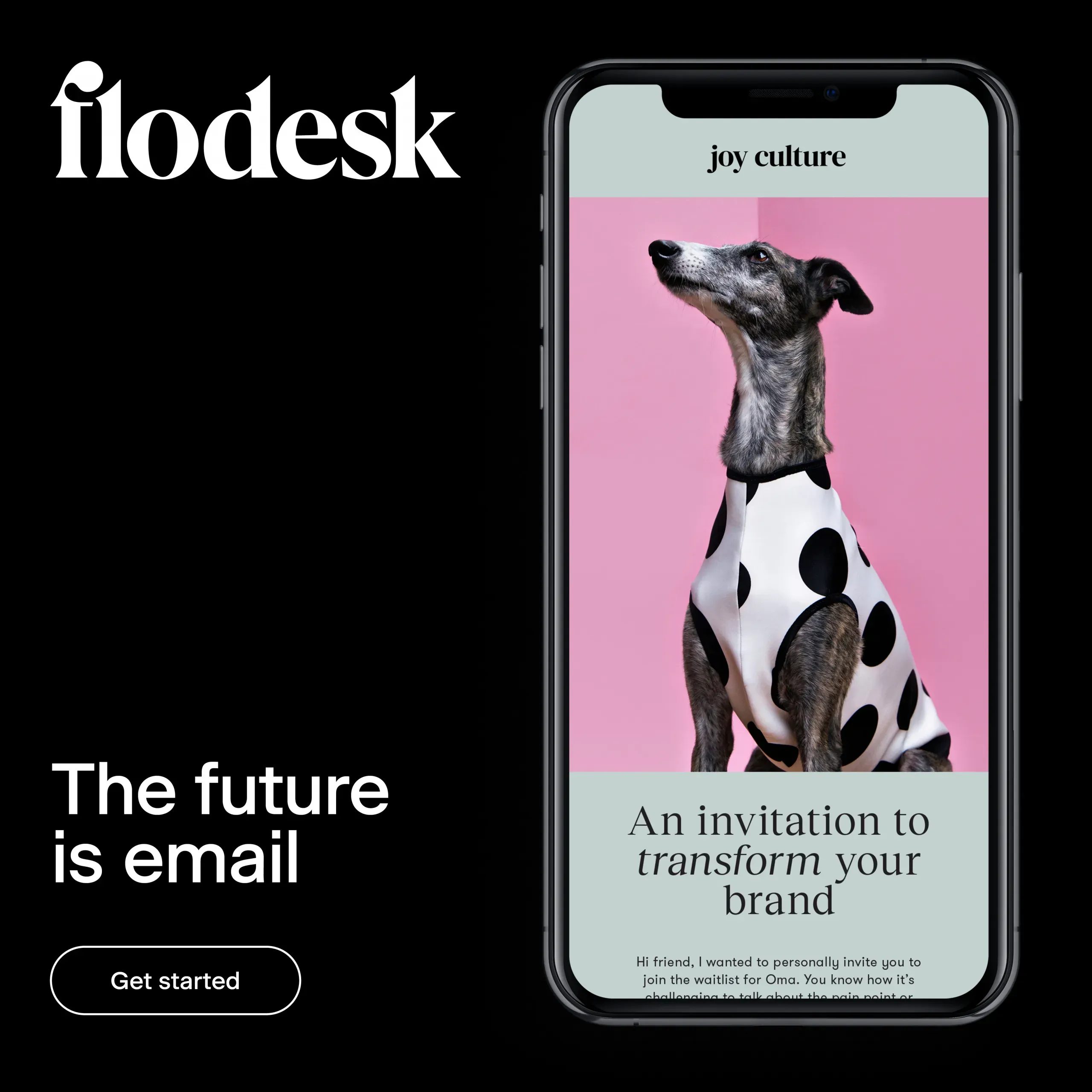
Loyalty program email FAQs
How do you announce a loyalty program?
One of the best ways to announce your loyalty program is by using your website or blog. Not only is it free, but it will also attract customers who are already interested in your product. If you’re launching a loyalty program that’s in addition to your newsletter or subscription list, you can also announce it via email to current subscribers.
What is a loyalty email?
Loyalty emails come in all different shapes and sizes, from welcome emails to special offers to product updates. The thread that connects them all, however, is that a loyalty email provides customers or subscribers with some type of value that no one else gets.
Why send customer loyalty emails?
The benefits of sending loyalty emails include increased purchase frequency, higher customer lifetime values, better customer engagement, stronger customer relationships and more referrals.